
Platydoris striata
(Kelaart, 1858)
Order: NUDIBRANCHIA
Suborder: DORIDINA
Superfamily: EUDORIDOIDEA
Family: Dorididae
DISTRIBUTION
Indo-West Pacific
PHOTO
Hurghada, Red Sea, July 2000. Photo: Roland Wantens.
This species, with P. scabra, P. formosa and P. cruenta form a group of very similar species, two of which have brown spots and two have brown lines. In each pair, one species has red spots and the other does not. The brown spotted pair are P. scabra (without) and P. formosa (with red patches) while the lined pair are P. striata (without) and P. cruenta (with red patches).
Note added 29 Aug 2007: Dorgan et al (2002) consider P. striata to be a synonym of P. cruenta. See my comment in message #20542.
- Dorgan, K.M., Valdes, A. & Gosliner, T.M. (2002) Phylogenetic systematics of the genus Platydoris (Mollusca, Nudibranchia, Dorididea) with descriptions of six new species. Zoologica Scripta, 31(3): 271-319.
- Kelaart, E.F. (1858). Description of new and little known species of Ceylon nudibranchiate molluscs and zoophytes. Journ. Roy. Asiatic Soc. Ceylon Branch, Colombo, 3: 8-139, with 2 unnumbered plates
Rudman, W.B., 2000 (October 3) Platydoris striata (Kelaart, 1858). [In] Sea Slug Forum. Australian Museum, Sydney. Available from http://www.seaslugforum.net/find/platstri
Related messages
Re: Platydoris striata from Reunion Is.
April 25, 2008
From: Philibert Bidgrain
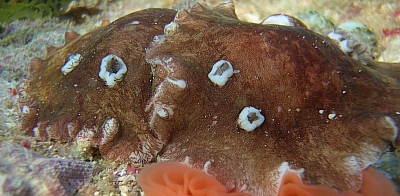
Concerning message #20542:
Dear Bill,
Reunion Island seaslugs
Are these a variant of Platydoris cruenta or P. striata? These two different specimens (upper photo from Madagascar and lower photos from Reunion Island) look like P. striata but also to the supposed P cruenta specimen (see my preceding message #20613 ). I haven't good photo of the underside of these specimens, only an old photo of a dead specimen which are very similar to our P. cruenta specimen ( brown lines not dots and absence of red patches)
Photos: Length: 50-70 mm. Photographer: Alain Barrére.
All these specimens are very similar except for the very small red patches on the dorsal side of the 'P. cruenta'.
What's your opinion about these specimens ?
Best regards
Philibert Bidgrain
http://vieoceane.free.fr/runseaslug/indexslug.htm
pbidgrain@yahoo.fr
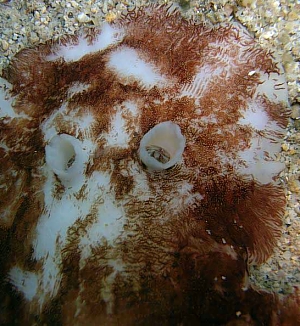
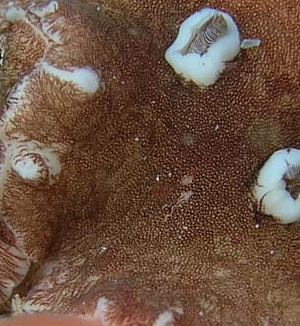
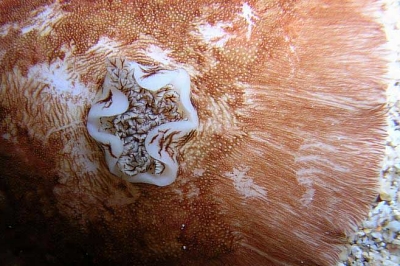
Dear Philibert,
I would agree there is little to separate P. striata and P. cruenta other than the red spots in the latter but as I have discussed previously [message #20542] I think we need a case to be made for synonymising the two species.
Best wishes,
Bill Rudman
Re: Trailing Platydoris striata from the Red Sea
September 26, 2007
From: Kamal El Tawil
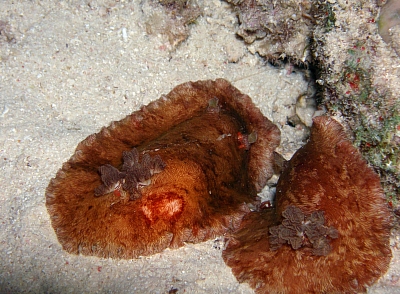
Concerning message #20762:
Dear Bill :
Many thanks for your reply to my message. You say it is surprising how they can distort and squeeze their bodies to fit in seemingly impossible spaces. This is exactly what I observed with these two animals and I attach a picture of the little crevice in which they disappreared into.
Kindest regards,
Kamal El Tawil
www.coralworld.net
kamal@coralworld.net
El Tawil, K., 2007 (Sep 26) Re: Trailing Platydoris striata from the Red Sea. [Message in] Sea Slug Forum. Australian Museum, Sydney. Available from http://www.seaslugforum.net/find/20787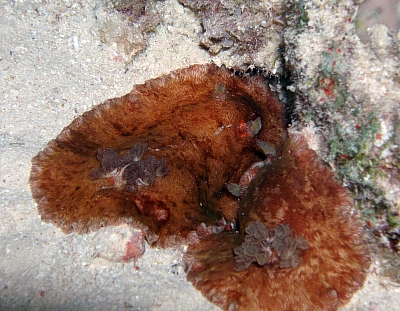
Thanks Kamal,
I wish I had taken photos of distorted and twisted animals - but like everyone else I usually wait until they look more photogenic.
Best wishes,
Bill Rudman
Trailing Platydoris striata from the Red Sea
September 22, 2007
From: Kamal El Tawil
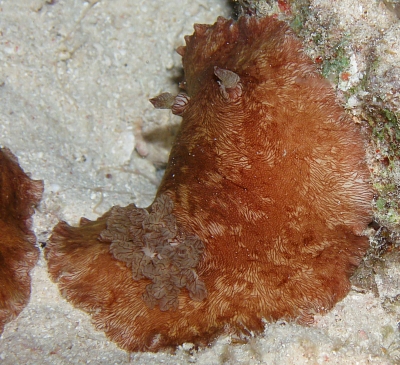
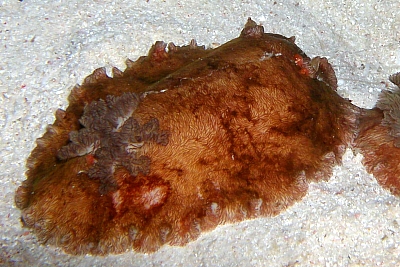
Dear Bill,
I suspect these are Platydoris striata. Ii found them on a night dive trailing on a sandy bottom. They seem to be shy animals as they disappeared in a small crevice escaping my dive and strobe lights. There are only 3 postings for this species on the Forum, is this an indication that these animals are rarely seen ?
Locality: Shuab Sweedy near Toyota wreck, 12 meters, Sudan, Red Sea, 13 april, Offshore reef. Length: 150 mms. Photographer: Kamal El Tawil.
Kindest regards,
Kamal el Tawil
www.coralworld.net
kamal@coralworld.net
El Tawil, K., 2007 (Sep 22) Trailing Platydoris striata from the Red Sea. [Message in] Sea Slug Forum. Australian Museum, Sydney. Available from http://www.seaslugforum.net/find/20762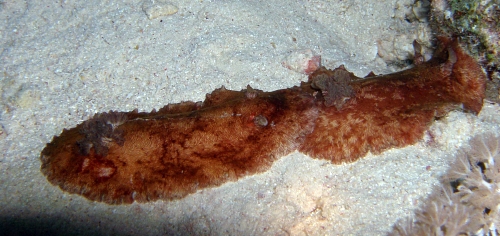
Dear Kamal,
This is what I have always called P. striata, but a recent publication has considered that species to be a colour form of the red-spotted P. cruenta [see my comments #20542 on why I think we should at least at present retain P. striata].
It's interesting to see another opisthobranch 'trailing'. What appeared to be chromodorid behaviour seems to be quite widespread. Concerning how rare they are, it's a bit hard to say. A lot of these large 'flat dorids' are not that commonly seen. Personally I think they are much more abundant than we think but they are extremely well camouflaged and are often found in loose coral rubble and areas with lots of cracks and crevices. It is surprising how they can squeeze and distort their bodies to fit into seemingly impossible spaces, including the middle of a dead Acropora skeleton. I think we probably just don't see most of them.
Best wishes,
Bill Rudman
Platydoris striata from the Seychelles
August 30, 2007
From: David K A Barnes
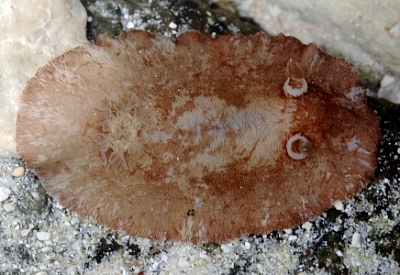
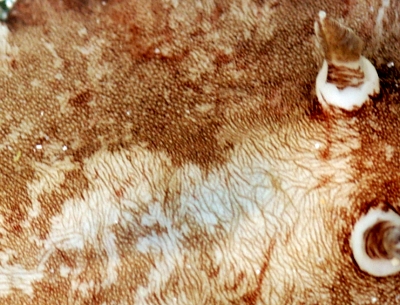
Does anyone recognise this, we thought it might be a platydorid, sorry photos only.
Locality: Silhouette Is, Intertidal, Seychelles, Indian, August 2007, rocky reef. Length: ~4 cm. Photographer: Richard Barnes.
Richard Barnes
dkab@bas.ac.uk
Barnes D.K.A., 2007 (Aug 30) Platydoris striata from the Seychelles. [Message in] Sea Slug Forum. Australian Museum, Sydney. Available from http://www.seaslugforum.net/find/20542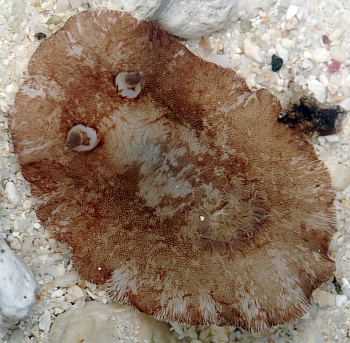
Dear Dave,
This is indeed a Platydoris, and from the brown lines on the mantle I would identify it as Platydoris striata. You will see on the brief Fact Sheet I note that there is a pair of species with brown lines on the mantle and a pair with small brown spots. Each pair has one species with large red patches and one without. The brown-lined pair consist of your species, P. striata, and a red-spotted species, P. cruenta. Dorgan et al (2002) consider P. striata to be just a colour form of P. cruenta which lacks red spots. Their argument for synonymising the two species consists of the one sentence:
"This colouration [of P. striata] matches that of specimens of P. cruenta lacking red blotches, and therefore these two names are regarded as synonyms"
which is what I would call a rather circular argument. It would have been useful if they gave some evidence of comparing the anatomy of the two 'colour forms'. It is strange they merged this pair of species with so little effort and yet retained the pair with brown spots, P. scabra and P. formosa, with no mention of their colour similarities.
It may be that P. striata is a colour form of P. cruenta but I consider synonymising species to be a much more exhaustive job than naming new ones, so will wait until someone produces some evidence. Another possibility is that it is another species. In an earlier message from Erwin Koehler [#4562] of an animal from the Seychelles, I tentatively identify it as P. scabra because it lacks brown lines, but both it and your animal have white rhinophore sheaths, whereas in P. scabra, P. striata. P. formosa and P. cruenta have brown spots or lines as elsewhere on the mantle.
I don't suppose you have a photo of the underside?
- Dorgan, K.M., Valdes, A. & Gosliner, T.M. (2002) Phylogenetic systematics of the genus Platydoris (Mollusca, Nudibranchia, Dorididea) with descriptions of six new species. Zoologica Scripta, 31(3): 271-319.
Best wishes,
Bill Rudman
Platydoris striata from Christmas Island
May 2, 2002
From: W.B. Rudman
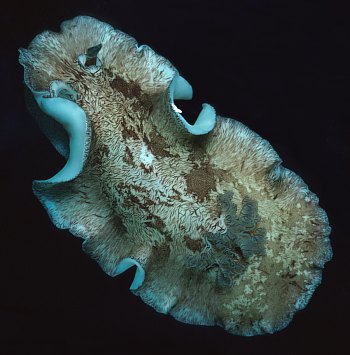
Here is a photo of Platydoris striata from John Hicks' Christmas Island, Indian Ocean collections.
PHOTO: AM C137596, 90 mm long alive. 13 November 1982, Public swimming pool, Christmas Is., Indian Ocean. Photo: John Hicks
Best wishes,
Bill Rudman
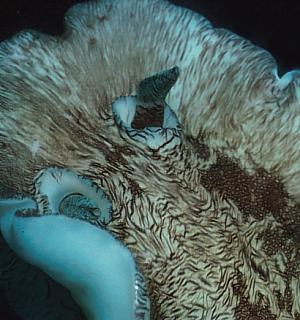
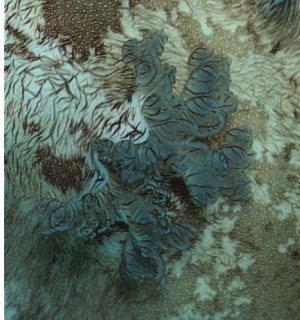
Platydoris striata from Red Sea
October 6, 2000
From: Erwin Koehler
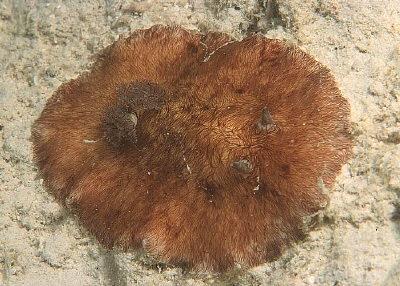
Dear Bill,
This one is from the Red Sea, Hurghada, July 2000. It was taken by Roland Wantens
Email Roland.Wantens@antwerpen.be
Erwin
Medslugs.Koehler@t-online.de
Koehler, E., 2000 (Oct 6) Platydoris striata from Red Sea. [Message in] Sea Slug Forum. Australian Museum, Sydney. Available from http://www.seaslugforum.net/find/3113Dear Erwin,
This is a nice photo to get. It is Platydoris striata which I mentioned recently when talking about Platydoris scabra, but unfortunately didn't have good photo of.
Best wishes,
Bill Rudman.
